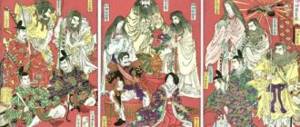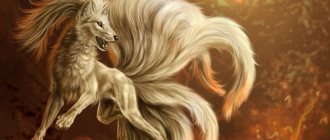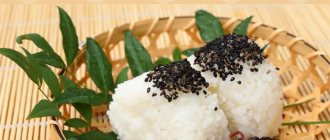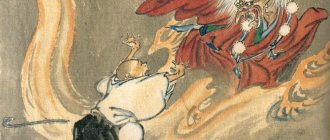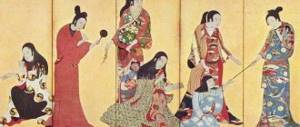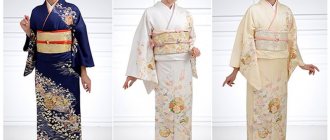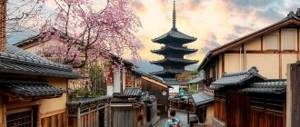Seven gods of happiness
India, Japan and China gave us deities that, when brought together, are the strongest talisman - the seven gods of happiness. They are often depicted as netsuke, figures that sail together on the Takarabune (Treasure Ship) boat to Japan. It is in this country that it is customary to give figurines of a magic ship and wish happiness for the New Year. Then various amulets and talismans are placed in them. In Japan, it is customary to give these gods as gifts in the first month of the new year. Interestingly, the composition of the deities is truly international. It is generally accepted that the so-called “seven sages from the bamboo grove” served as the prototype for the gods.
According to legend, the Buddhist monk Tenkai (Jigen-Daishi) holds the right to discover these deities. He had a truly philosophical mindset, analyzed the seven blessings of sutras, religious treatises, and on this basis determined his own qualities for each deity. In the third century AD, he brought together longevity, contentment, material wealth, fame, honesty and courage and assigned these characteristics to each of the deities. The result was seven gods of happiness. And all this has survived to this day, being used with no less success.
The history of the 7 gods
The roots of the formation of this seven gods go back to China, in the 3rd century AD. It is generally accepted that the prototype of the gods in the current perception are the seven sages from the bamboo grove (Zhu-lin-qi-xian) - Yuan Xian, Xiang Xiu, Ji Kang, Yuan Ji, Wang Rong, Shan Tao and Liu Ling.
According to other sources, eight immortals or eight sages were taken as a basis from the mythology of Taoism, who, following the path of Tao, gained immortality and bliss. The path of the seven gods of happiness Shichifukujin has a long history. In Japan, the ancient Buddhist sutra “Ninno hannya kyo” is well known, in which it is written “seven misfortunes will immediately disappear, and seven blessings will immediately appear.”
Under this influence, the idea of the seven gods of happiness was formed. Next, they tried to determine seven types of happiness artificially, by order of the Emperor of Japan. The Buddhist monk Tenkai (Jigen Daishi), known for his philosophical mindset, compared the seven blessings of the sutra with the seven gods and suggested the following types of happiness: longevity, material well-being, contentment, wisdom, fame, honesty and courage.
However, folk art intervened in this process and such laconic formulations regarding the seven types of happiness gradually changed, as did the gods to whom certain benefactors were attributed.
Japanese Shintoism is very loyal to other religions, so it is not surprising that the seven gods of happiness placed in Takarabune's boat (see below) were derived from other beliefs, with the exception of Ebisu, the only one of the seven who is a Japanese god. Of the thousands of gods worshiped in Japan, the place of the seven gods of happiness was taken by one or the other. From the 18th century to the present time, the following gods are considered to be the seven gods of happiness.
Takarabune - Treasure Ship, on which the seven gods of happiness sailed from China to Japan. It is generally accepted that a magic ship is always on its way to another, mysterious and happy world. In Japan, figurines of a magical ship are given as gifts for the New Year with wishes of happiness.
Later, all kinds of amulets and talismans are placed in the boat. Children put it under their pillow on New Year's Eve, and the wishes the child makes come true. Since the 15th century, the seven gods of happiness have been depicted in Takarabune. In Japan, it is customary to give the seven gods of happiness in the first month of the year.
Source: www.domduha.ru
Religious world of Japan
The religious picture of Japan consists mainly of two components - Buddhism and Shintoism. If the Russian-speaking reader may still know something about the first of them, then traditional Japanese Shintoism most often presents a complete mystery. But it is from this tradition that almost all traditionally revered Japanese gods and demons come.
It is worth saying that formally the overwhelming majority of the Japanese population associates themselves with Buddhism and Shintoism - up to more than ninety percent, according to some studies. Moreover, almost all of them profess both religions at once. This is a characteristic feature of Japanese religiosity - it gravitates towards a syncretic synthesis of different traditions, combining various elements of both practice and doctrine. For example, Japanese gods, originating from Shintoism, were adopted by Buddhist metaphysics, and their veneration continued in the Buddhist religious context.
Seven Gods in Japanese Culture
In the 14th century the cult of the seven gods reached its peak. This was especially true in the capital of Japan, Edo, where there was a custom of annual pilgrimage to temples dedicated to one or another god of happiness. This pilgrimage took place in the first month of every year.
And now those who urgently need divine support or who want to escape from the daily whirlwind and, under the shadow of sacred temples, indulge in unhurried thoughts about the eternal, go on a small journey - a pilgrimage to temples associated with the gods of luck.
The temples are located close to each other so that devotees can tour all seven temples in one night. There are several such “ring routes” in Tokyo. The most popular of them runs along the banks of the Sumida River and is approximately three kilometers long. There are signs along the entire path, so it is difficult even for a stranger to lose his way. You can go the whole way alone, but there is also the opportunity to join a group of pilgrims.
In each of the temples, a visitor can put a colorful stamp on a specially purchased card, which thus itself becomes a talisman and a “guarantee” that luck will not abandon its owner.
Pilgrims buy small figurines of the seven gods in the temples - separately or all together on a small treasure ship - Takarabune. After all, it is loaded not only with gold and rice, but also with wisdom, longevity, health, and good luck.
Most often, temple visitors buy the ship depicted in the engraving.
This drawing should be placed under your pillow on New Year's Eve. The Japanese are confident that the first dream in the New Year is prophetic and determines fate for the whole year. It is best if you see Mount Fuji, hawks, or... eggplant.
Noble Mount Fuji, a smart and strong bird, but an eggplant? This came from a statement by Shogun Tokugawa: when he learned about the cost of the first eggplants of the season, he was very surprised and said that only Mount Fuji and Mount Ashitaka (taka - hawk) were more expensive (higher) in his province.
It is also said that Mount Fuji, falconry and the first eggplant of the season were the shogun's favorite things. So a dream about an eggplant is perceived as a clear forecast of a happy year.
Those who are unlucky with their dreams, who dream of something unpleasant, can get rid of the obsession by throwing a leaf with the image of Takarabune into a stream or river in the morning. Then a bad dream - a harbinger of bad luck - will be carried away by the waves far out to sea.
Source: www.livemaster.ru
Bishamon (Tamonten)
Initially, he did not play the role of the god of happiness, he was responsible for war and warriors. That is why he is still depicted with a sword in his hands or a spear and wearing full samurai armor. He was assigned to be one of the four protectors of Buddhist temples.
Origin
Bishamon-ten (bishamon) - Tamon-ten - phonetic calque from Sanskrit of the Hindu god, heavenly messenger Vaishravana, in Buddhism - Tamon-ten (mythologically protects the places where Buddha preaches), - a warrior god.
He fights on the side of good, but since there is still enough evil, he has to fight a lot. Bishamonten lives on the slope of Mount Meru, which is crossed by the axis of the world. He lives on its northern slope and is called the guardian of the North (guardian of the lokapala).
According to more ancient legends, for the first time the figurine of Bishamon-ten mystically came from one wise hermit who lived on Mount Shigi, bringing him a well-deserved reward for his righteousness. Later the war passed into the hands of the valiant Kusunoki Masashige, who named his son Bishamon-ten. Since the 15th century in Japan, it was customary to install the image of Bishamon-ten on the kamidana (stick for the gods) to quickly achieve happiness.
What does it look like
Bishamon-ten, usually in armor and a helmet, holds a sword or spear in one hand, sometimes a trident, and a small pagoda (hoto) in the other. He protects the sacred pagoda and distributes treasures from it to the worthy. Bishamon-ten is often identified with the Shinto god of war Hachiman (Hachiman), whose messenger was once a dove, which is now also Bishamon-ten's bird.
There is one secret. In practice, it is known that there are not many good people in the world and Bishamon can destroy his gifts. He is not only a warrior, but also the patron of the military, lawyers and doctors. They give the figurine to people of relevant professions with wishes of prosperity and happiness.
He was especially revered during the Heian period (794 -1185), when there were wars for the development of Honshu, the largest island in the north of the country. In the old days, this god was often identified with another warrior - Hachiman. In the Tsurugaoka temple complex dedicated to the latter, where the monks prayed for victory in the upcoming battles, doves always sat on the roofs, serving as messengers of the divine will.
Later, these same birds became Bishamonten's messengers. A miniature figurine of a warrior god provides invaluable assistance to its owner, defending justice and attracting victory in the most difficult “battles.”
To whom to give
Bishamon-ten brings justice, good luck and happiness. Patronizes soldiers, doctors and priests. They give a figurine of Bishamonten with wishes of financial prosperity and happiness.
Ideas about Kama as the personification of desire
“Behind his back hangs an onion, Sugar cane, covered with bees, - Which are born when the buds of flowers open in the spring. His arrows are a symbol of his varied strength. Each arrow is a flower in a special form.”
From the poem by Letitia Elizabeth London “Manmad In. Indian Cupid sailing on the Ganges"11.
Desire is the first thing that arose in the primary embryo of the mind and revealed the connection between the existing and the non-existent, that is, it gave rise to the impulse towards manifest existence. In the Atharva Veda it is mentioned that Kama is the first manifestation in the world, no one can be like him: neither gods nor people. No desire - no action, no life, because there is no incentive to move.
Without desires, a person turns into a living dead. However, it is important to understand what the nature of desires is. They either lead along the Path of evolution (desires for development, spiritual growth, self-improvement), or lead to degradation (aimed at satisfying selfish needs emanating from false self-identification).
“One who is completely unconcerned with the pursuit of pleasure is called completely enlightened. Such perfect enlightenment arises from complete renunciation of the pursuit of pleasure. One who is in awareness does not feel aspirations at all. The desire for pleasure arises only when deviating from Consciousness.”
"Yoga-Vasishtha", chapter 6 'On liberation'.
Let's consider how the concept of Kama-desire is interpreted in various sources and ancient scriptures.
Firstly, Kama refers to one of the four goals of human society (Purushartha): Artha (prosperity), Dharma (virtue), Kama (love and desire), Moksha (liberation). Kama is just such an aspiration.
Secondly, the form of Kama is threefold and consists of Tamas, Rajas and Sattva. Tamas represents desire based on attachments. Rajas is based on desire for the purpose of obtaining pleasure. And Sattva is the desire for simple pure nature.
Kama is also seen as a passionate attraction to something. There are three types of passions12:
- Dharmakama - passion for virtue;
- Arthakāma - passion for wealth;
- Mokṣakāma - passion for Liberation.
In Buddhism13 Kama represents sensibility, both subjective and objective. Subjective includes the following manifestations: kama-chanda (sensual desire), kama-raga (sensual attachment), kama-tanha (sensual attraction), kama-vitakka (sensual thought). The objective represents kama guna (which includes five threads of sensuality that awaken attraction to objects of the material world that a person perceives through the senses).
Buddhism also describes three types of desire: Kama-tanha - the desire to gain something besides what is, or to make up for what is missing; Bhava-tanha - the desire to become someone when there is a feeling of being deprived of something; Vibhava-tanha is a desire generated by disappointment when we strive to get rid of something unnecessary, superfluous. All of them must be released by recognizing our desires without identifying with them and seeing that all these desires are caused by our mind and are therefore impermanent. Therefore, desire is not part of us, it comes from a conditioned self-identification that is associated with our self, the personality of this incarnation.
Benten (Benzaiten)
The only female deity among the seven gods is the ruler of the waters, Benzaiten, who protects from disasters and shocks. It promotes the manifestation of talents, teaches eloquence, patronizes dancers, singers and poets, and brings spiritual and physical harmony.
Origin
Benzaiten (Benten) is the only female image among the seven gods of happiness. Goddess of longevity, fertility, water, music, art, eloquence, protects from natural disasters. Now more details.
According to legend, Benzaiten was able to defeat a terrible dragon that devoured children. Having caused an earthquake, she destroyed the cave in which the dragon lived, charmed him and married him, thereby stopping his outrages.
8According to other legends, the dragon turned into a white snake with the head of a monk and became tame, and Bendzaiten became a protector from snakes. But in Japan there is also a common noun for her - when they talk about female beauty as something insidious or useless, a woman is called Benzaiten. In addition to being purely Japanese in origin, like almost all of the seven gods, Benzaiten has another history related to Vedic origins.
The prototype of Benzaiten are three Hindu goddesses: Saraswati, who, being the goddess of wisdom, passed on her ability to speak, Maharshi and Lakshmi.
From pre-Buddhist legends, it is believed that she adopted the gift from the mistress of water, the White Snake. The smoothness and musicality of Bendzaiten's speech is like the flow of water. Her appearance as a goddess owes more to the female form of Bishamonten (Kichijōten), who is considered the incarnation of Benzaiten.
What does it look like
Benzaiten is often depicted playing the biwa, a Japanese mandolin or sacred lute. Therefore, her figurine will be useful to people of art - musicians, artists, writers. She is always ready to give inspiration and help make beautiful fantasies come true.
This deity is often depicted with an uchide no kozushi - a magic mallet. Each of her blows fulfills a wish made by the children. When Daikoku shakes his mallet, coins miraculously fall out of thin air.
Some Japanese believe that if you knock on the ground three times with the symbolic Daikoku mallet and make a wish, it will certainly come true.
To whom to give
In people of creative professions, Benzaiten inspires and imparts abilities in music, literature and painting. As a gift, it protects against natural disasters and promotes longevity and correction of tongue-tiedness.
Kamadev - the god who teaches lessons through suffering
“The entire universe is clothed with desire. Desire is the enemy of knowledge and light. The enemy of wisdom - wisdom plunges into flames, That greedy flame in the guise of desire."
"Bhagavad-gita".
So Kamadev is the god who personifies the human power of desire of any kind. But selfish desire, as we know, leads to suffering. If suffering did not follow the achievement of such desires, there could be no talk of any development. But Kamadev teaches us lessons precisely through the comprehension of bitter experience - the price to pay for following the path of selfish aspirations.
This sooner or later rejects such desires from a person who has clearly recognized the illusory, frailty and fragility of the imaginary happiness obtained thanks to them. Suffering seems to “burn out” all the passions that overcome us. Which, in turn, leads to the emergence of sublime desires in our hearts.
“Through suffering, the desire for liberation arises.”
"Sankhya Karika".
The first people created by Brahma, according to the Vishnu Purana (Book I, Chapter VI), were pure in mind, and in the depths of their hearts the Light of the Almighty shone, but soon Kala14 sowed the seed of wickedness in them, which subsequently gave rise to lust, and it awakened passions and others selfish impulses. This led to pain and suffering that arose from sharply opposite sensations.
People were divided into those who eradicated the manifestations of this seed in themselves, and those “in whose minds the seed of egoism created by Kala grew magnificently.” All the hopes of such bad people are in vain, everything they want is doomed to destruction. Here we are talking about the fact that physical love is a type of pain, and only the wise, who has comprehended all three types of mental and physical suffering (Adhyatmika, Adhibhautika, Adhidaivika), gains detachment from the objects of the material world and achieves final Liberation.
“In this world, contentment with what you have is the best medicine and the greatest luck. A contented heart is ready for enlightenment.”
"Yoga-Vasishtha", chapter 6 'On liberation'.
In ("Skanda Purana", chapter 21, part 1) it is said that “Kama-Ananga is the cause of the fall of all living beings, he is the “embodiment of suffering”, so Shiva burns him with the flame of his third eye, “freeing the entire Universe from Kama- love and Krodha-anger, which existed already at the dawn of the Creation of the universe.” Krodha originates from Kama. Krodha (anger) is its relative, as stated in the Skanda Purana, and it has incredible power. Together they (Kama and Krodha) conquered and filled the world with themselves. According to the Mahabharata, desires and anger are sources of suffering for those who are in ignorance.
The Mahabharata (Book XII) says that there are no other bonds that hinder the Path to Liberation except the bonds of Kama. And cutting the bonds of Kama is the essence of Liberation. Kama is called “the creator of labor, thirst and grief, lust, greed, despondency,” due to the constantly arising aspirations to satisfy insatiable desires.
“Freed from desires, like a moon shining in the heavens among scattered clouds and fog, Like a deep ocean, remaining unchanged, in which river waters disappear; It is he who achieves peace, and not the one who strives to satisfy endless desires. One who is free from Kama ascends to heaven.”
"Mahabharata", book XII "Pacification", chapter 251.
In the Mahabharata (Book XII, Chapter 177), Manki, who once coveted earthly wealth and worldly prosperity, but constantly fails in his aspirations, comprehends the frailty and meaninglessness of desires and speaks the following words: “Having tamed my feelings, having mastered myself, I renounce all desires of the heart, having left you, Kama, who hitherto dwelt in me. I will calmly treat those who slander, I will not harm those who harm, I will speak friendly to those who indulge in hatred, and I will not pay attention to hostility. Since you are detached from desires, you are happy!”
Daikoku
Direct patron of wealth and keeper of the hearth.
Origin
Bring the beauty of your soul to perfection, then wealth and luck will flow to you, and you will only have to taste their fruits, - a phrase spoken by Lao Tzu is embroidered on the Daikoku bag and personifies the essence of this god. The prototype of Daikoku came from Buddhism in the form of Mahakala, who was worshiped as the god of wealth and the guardian of faith (guardian and protector of the teachings of the Buddha).
Some associate it with Shiva. But the three-headed and six-armed god Mahakala in this image did not take root in Japan and received a traditional Indian image: in trousers, a hunting suit and a hat with a twisted brim or a peasant hood.
A benevolent fat man with huge ears, a beard or mustache - sheer benevolence and willingness to accept requests. There is a Japanese analogue to Daikoku in Shinto - the deity Okuninushi no Mikoto.
What does it look like
He is depicted sitting or lying on a bag, and sometimes getting out of it, sometimes with two or even three bags, sometimes with a mortar, pounding rice. In his hand, Daikoku usually holds a hammer, a magic mallet (uchide-no-kozushi) or (uchide-no-kozuchi).
After each blow of the hammer, precious stones, coins or rice fall out - whoever needs what. Rats sometimes scurry around inside the big bag, but this is good, because where there are rats, there is prosperity, and through the gnawed holes rice pours directly into people’s hands.
According to another legend, the rat helped Daikoku escape from the angry gods who wanted to punish him for his discourtesy. Since then, the rat, like a faithful friend, always accompanies him. Daikoku is often depicted together with Ebisu.
Despite his mercantile attributes, Daikoku is not greedy or a hoarder. His image speaks of spiritual wealth. There are netsuke Daikoku, on the bag of which lines from Lao Tzu’s treatise are inscribed: “Bring the beauty of your soul to perfection, then wealth and luck will flow to you, and all that remains is to taste their fruits.”
Rats often sit on the Daikoku bag containing the magic rice. From the holes they gnaw, the contents of the bag generously pour into people’s hands. Such a gift will undoubtedly delight businessmen and managers who need wise decisions on which the well-being of themselves and the people around them depends.
To whom to give
Giving a gift to Daikoku means wishing good luck, wealth and prosperity. If you rub your palms in the form of netsuke with this deity, then good luck and happiness will come to you. Daikoku was depicted on one of the first payment papers in Japan.
Shintoism is the essence of religion - briefly.
In simple words, Shintoism is not exactly a religion in the classical sense of the term, but rather a philosophy, idea and culture based on religious beliefs. In Shinto there are no specific canonical sacred texts, no formal prayers and no obligatory rituals. Instead, worship options vary greatly depending on the shrine and deity. Very often in Shinto it is customary to worship the spirits of ancestors, who, according to beliefs, constantly surround us. From the above we can conclude that Shintoism is a very liberal religion aimed at creating the common good and harmony with nature.
Hotei
There is no god of happiness more cheerful and cheerful than this carefree fat man with a wide smile. In his hand he has an ordinary bag, from which he is able to endow every person with real wealth.
He is one of the seven gods of happiness with full right, since he can make everyone happy who seeks his protection. It is interesting that this is the only one among the seven gods who had his real life incarnation.
Origin
Hotei is credited with the appearance of a real prototype - the wandering monk Qi Qi, who brought prosperity and good luck with him. Subsequently, the visual image of Hotei was taken from this monk. Although the monk was Chinese, Hotei is of more Japanese origin. The name Hotei in Japan is translated as a canvas bag (Ho Tei), since he always traveled with such a bag. From this bag he distributed to people everything they needed.
To the question - what's in the bag? he answered - the whole world is there.
Later, the contents of his bag came to be considered the Great Emptiness (Ta-Khun), which represents the nothingness from which the great everything was born. After the death of the monk, Hotei began to be considered the eighth incarnation of the Buddha, Maitreya Buddha. In Western culture, Hotei is called the laughing Buddha.
According to the canons of Buddhism itself, Buddha Maitreya is a bodhisattva of the ninth level, who will be born as Buddha Manushi 5000 years after the death of the great Shakyamuni Gautama, whose arrival will be the achievement of world harmony.
Now he lives in the heavenly country of Tushita (Garden of Joy) and, according to Japanese legend, in the form of Hotei he descends to people to please them. Canonized as the god of carefree and happiness in Japan in the 17th century.
https://www.youtube.com/watch?v=fneGP0Bav2Q
What does it look like
Hotei is depicted with a canvas bag, with a staff, sometimes holding a gold bar, a pearl or coins. Sometimes with children. Hotei with a pearl represents wisdom. Okimono Hotei is depicted with magic mushrooms. A sitting Hotei is a female talisman, a standing one is a male talisman. The only mortal god among the seven gods of happiness.
Hotei is traditionally depicted with elongated earlobes and a large belly - the embodiment of the life-giving energy of qi.
In Japan there is a belief: any wish will come true if you stroke a Hotei figurine on the stomach. Such a talisman is designed to relieve financial difficulties and give material well-being. It makes spouses happy, and ensures academic success and harmonious development for children.
Usually it is given to close friends to wish all sorts of blessings, abundance and fulfillment of desires. As a talisman, it is given to young children. Our older generation remembers the little smoker - this is a manju-netsuke, even with a pipe.
The smoke released by Hotei forms a specific hieroglyph (kotobuki), which means a wish for longevity and prosperity. In mythology there is a belief: if you rub Hotei on the stomach 300 times and at the same time think about your desire, then your desire will come true. A figurine of Hotei is always placed in a visible place indoors.
Activation of the talisman
Hotei figurines are very popular for attracting good luck and big earnings to your home. It is better to choose a golden or white figurine: the deity is capricious and has its own preferences. A cheerful god can help lonely people find a family: to do this, you need to buy a figurine in which Hotei is surrounded by children.
Activating the talisman is very simple: you just need to rub the figurine on the belly. In ancient times, the Japanese believed that if you rub Hotei’s tummy three hundred times while thinking about what you want, your wish will definitely come true!
Source: mlady.org
Jurojin
Origin
Most of the legends about Jurojin are similar to the origin of Fukurokuju, the appearance and attributes are also the same, with the exception of the shape of an elongated bald head. Jurojin has a normal skull shape and is often covered with a cap. According to his divine purpose, Dryurojin is the god of longevity and respect for old age.
The status of the talisman of the god of happiness came from his ability to give longevity. In this regard, he is usually depicted as an old man with a long white beard. His head is covered with a cap, which is more suitable for a scientist. In his hands he carries a shaku staff, which has a scroll of wisdom attached to the top. According to legend, it records how long each living creature is given to live on earth.
Other beliefs say that the scroll contains the secret of longevity and a happy life. Usually his companions include a turtle, crane or deer. These creatures are known in the east as symbols of longevity. Interestingly, Jurojin is sometimes depicted drinking sake. At the same time, it can be a talisman that protects travelers.
Source: www.domduha.ru
Fukurokujin (Fukurokuju)
God of longevity and wisdom. The name comes from fuku - wealth, roku - career, happiness, ju - longevity. He is depicted as a very old man with an elongated head (phallic symbol).
Origin
Fukurokuju has Chinese history. According to one version, a certain Fukurokuju dissuaded the Emperor of China (Liang dynasty, Emperor Wu, 5th-6th century) from recruiting young men from one of the villages, which earned him the gratitude and veneration of its inhabitants. Since then, his image has acquired the ability to perform miracles and bring prosperity.
According to Chinese traditions, Fukurokuju is the incarnation of the South Pole Star.
It is generally accepted that the prototype of Fukurokuju are the gods of Taoism - Shousin (the Elder of the South Pole, as well as the faithful companions of Shaoxing - Fuxing - the god of happiness and Luxing - the god of career.
This is confirmed by the spelling of the name. In Japan, Fukurokuju is written in three hieroglyphs: fuku - abundance, wealth (Fushin also from Japanese fuku, roku - translated as happiness (Lusin in Japan - rank, career), ju - longevity (Shousin, Lusin and Fushin from Chinese - triad of stellar spirits).
Another legend
He loves to play chess. The following legend is connected with this: one day a farmer, returning home, saw two old men playing chess. The farmer stopped, watching the game, and it seemed to him that after each move the beards of the opponents became longer and longer.
The match was long, and the bearded, long-headed old man treated the peasant to strange-tasting fruits to satisfy his hunger. A long time passed when the farmer finally noticed that the day was over and politely said goodbye to the players.
Rushing home, he discovered that the house no longer existed. The stunned farmer eventually learned that 200 years had passed while he had been watching the chess game.
What does it look like
A benevolent and respectable old man with a long white beard and an incredibly elongated head (the main feature), signifying wisdom, is usually dressed in Chinese clothing, which is often depicted in netsuke as a tortoise shell.
Sometimes Fukurokuju holds a staff, a fan and a scroll in which all the wisdom of the world is written (sutras - sacred texts).
Sometimes depicted with a child or children. Nearby are a shik deer (1500 years old), a long-tailed turtle (minogame) or a tsuru crane. All accompanying Fukurokuju in Japan are also symbols of longevity. Fukurokuju is often depicted in pairs with Jurojin and Daikoku, sometimes with the goddess of happiness Okame.
He is small in stature and has a long gray beard. Can be depicted with a fan in his hands and a scroll containing all the records of the wisdom of the world. Fukurokujin is able to give real longevity and true prosperity. They give a figurine of God to mature people with wishes of prosperity and long life. Also perfect for thinkers, scientists and those who are busy implementing new plans.
Fukurokuju's tall head embodies the exceptional wisdom he has gleaned over the long years of his life. However, she is clearly phallic in shape, which brings to mind Fukurokuju's friendship with the voluptuous goddess Okame.
Who do they give it to?
Usually Fukurokuju is intended as a gift to a person who has reached adulthood, who is wished for prosperity and long-term happiness.
Most often, watchmakers, chess players, scientists, thinkers, as well as everyone who is busy implementing something new, for example, builders of a new house.
Fukurokuju appreciates the art of wise contemplation, although he is not averse to humor and is not offended by good-natured banter. Figures of Jurojin and Fukurokuju are capable of attracting the patronage of the powers that be to the owner, and also serve as a guarantee of good health and longevity.
Ebisu
God of hard work and luck. Patronizes workers of various professions. Usually depicted with a fishing rod in his hands or a tai fish (carp).
It is usually pressed to the side or located behind the back. In a number of variations, the bream ended up under the god's arm, symbolizing his constant companion - luck.
By the way, bream was revered by the Japanese as the main fish among all marine life.
Origin
The first sources of mention of Ebisu belong to the 8th century. Born from Izanagi-no-Mikoro and Izanami-no-Mikoto, the baby had a birth injury - lack of bones, due to the mother’s improper observance of wedding rituals (allegedly, during the first intercourse, the wife was the first to utter joyful words - which was a violation).
To save his life, he was released into the ocean. Later, having matured, he climbed ashore and began to live among people.
Another legend about Ebisu
Ebisu was the son of the gods, the ancestors of the Japanese islands. He was born handicapped, without arms, without legs, and generally without bones. His name was Hiruko no Mikoto (or Hirako), which meant “tadpole.”
At a very early age (legend says that he was not yet three years old), he was carried out to sea on a reed boat (according to another version, his parents themselves let him go, believing that it would be better for him this way).
After long wanderings and overcoming many difficulties, Hiruko did not die, he remained alive, and his boat washed up on the shore of the island of Hokkaido. There he was picked up by an Ebisu fisherman named Ebisu Saburo. He fell in love with the little “tadpole” as his own son, raised and educated him.
At the age of 3, the boy grew arms and legs. Hiruko became a real full-fledged deity with the new name Ebisu.
And he began to help people. Especially fishermen and artisans.
When sailing, Ebisu protects fishermen from bad weather and, with his favor, gives a good catch. Ebisu is considered the god of hard work and helps only those who try to achieve everything through their own efforts. In rural areas, it helps people grow rice and protects them from drought.
What does it look like
Sometimes he is depicted as a master of a certain craft. Ebisu is considered semi-deaf from birth, so he always smiles or laughs.
In the plant world, the symbol of Ebisu is bamboo. Together with Daikoku (according to some sources, Daikoku is Ebisu’s father), Ebisu is considered the patron of trade, crafts, and at home, the keeper of the hearth and an assistant in the kitchen. Sometimes Fukurokujin is added to Daikoku and Ebisu, who is the third god of luck.
In March-April, schools of bream moved to the coast to spawn, where fishermen were eagerly waiting for them, and for this period Ebisu became the undisputed favorite among the “lucky seven”. The twentieth day of each month is considered Ebisu Day in Japan, and from January 9 to 11, Toka Ebisu is held - a holiday in his honor. Having become a popular talisman, Ebisu guarantees his fans good luck in business, self-confidence and inexhaustible optimism.
To whom to give
The figurine is given to fishermen for a favorable catch, small traders, as well as artisans. And in Japan, every 20th day of the month is called Ebisu Day.
It protects the house from fire and burglars. Together with Daikoku, they patronize any crafts and trade, and at home they are the guardians of the hearth and invisible assistants in household chores and in the kitchen.
Sometimes Fukurokujin is added to them and together they form a tandem of good luck.
Source: 1fenshui.ru
Location and activation of talismans
- Can be placed in the southeast, in the Wealth zone
- In the east, in the Family zone
- At the entrance door in the hallway
- In the office
Image of Daikoku and Ebisu
If the figures are used separately, then Daikoku can be placed anywhere, and they even say that to activate it, you just need to admire it more often. And it is advisable to place Ebisu near water (for example, near an aquarium or indoor fountain).
The Daikoku and Ebisu talisman is the patron of businessmen, merchants, traders, patronizes any endeavor related to the accumulation of wealth, good for protecting the home and for wishing good luck to children.
As you can see, its range of actions is quite wide. Therefore, you can purchase it both for yourself and as a gift for friends and family.
Sometimes a third hero is added to the pair Daikoku and Ebisu. This could be either Shou-shin (god of health and longevity) or Fukurokuju (god of wisdom).
Such “complex talismans” are considered extremely favorable.
Source: vash-fenshyu.ru
Image of Kamadeva
“Darkness or night is his elephant; fish is his flag; the parrot is his horse; Zephyr is his chariot; Spring is his ally. Rati, or love, is his consort; The moon is his royal umbrella; the cuckoo is his trumpet; the sea is his drum; sugarcane is his onion; the bees are his bowstring and the five flowers are his arrows, kindling thoughts of love.”
From “Tevaram”15.
Kama is usually depicted as a young and handsome youth with green, red or golden skin, with a bow and arrow, riding on a parrot Shuka, who is his vahana.
"Karanagama" describes how the image of the god Kama should be: "four arms, three eyes and a stunning look, one hand carries a snake, the other - akshamala16, the third and fourth are in patakahasta17 and the suchi gesture, respectively."
The bow belonging to the god Kama is made from sugar cane. Its arrows made of mango wood are called Chutashara (चूतशर, cūta-śara) or flower arrows (decorated with flowers) Pushpashara (पुष्पशर, puṣpa-śara), they are fragrant and full of honey. One of his arrows is called Kshobhana (क्षोभण, kṣobhaṇa) - “Exciting”; and there is also an arrow called Sandipana (संदीपन, saṅdīpana) - “Igniting” or “Awakening”. The Karanagama, however, gives names to the arrows such as: Tapini, Dakhani, Vishvamohini, Vishwamardini and Madini. The scriptures mention an arrow called "Mohana" ('Sorcerer'), which Kama shot at Shiva in order to slay his mind with the charm of Goddess Parvati.
His arrows are fragrant with the scents of flowers such as Ashoka tree flowers, white lotus, blue lily, jasmine and mango tree flowers. It is also believed that the five arrows of Kamadeva are the five senses, thanks to which interaction with the material world and its perception occurs, which entails the emergence of sensations, emotions and desires, as a result of which experience is formed and, in principle, the evolution of our individual consciousness is possible.
Kama is accompanied by a parrot, cuckoo or bees. The image of Makara, which is depicted on the banner of the god, is also associated with him. Here we can trace the connection between Kamadeva and the water world. As you know, water is the element of the emotional world, which is ruled by the god Kama.
